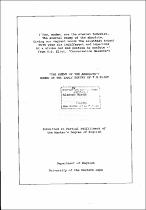| dc.contributor.advisor | Birch, Alannah | |
| dc.contributor.author | Birch, Alannah | |
| dc.date.accessioned | 2020-11-11T13:41:01Z | |
| dc.date.available | 2020-11-11T13:41:01Z | |
| dc.date.issued | 2002 | |
| dc.identifier.uri | http://hdl.handle.net/11394/7450 | |
| dc.description | Magister Artium - MA | en_US |
| dc.description.abstract | Mathew Arnold's 1867 poem presents romantic love as a condition of permanence that can offer refuge from a changeable world. Sixty years later, however, Virginia Woolf observes that romance has become rare as a subject of modern poetry. Her suggestion that there is an historical explanation for this change in literary subject matter is the starting point for this study of the representation of women in the early poetry of T.S. Eliot. Whereas Woolf tentatively dates the "death" of romance to the First World War I will suggest that this change in poetic
sentiment is evident in Eliot's early work, some of which predates the war. In the poems under discussion, written between the years 1910 ("Portrait of a Lady" and "The Love Song of J. | en_US |
| dc.language.iso | en | en_US |
| dc.publisher | University of Western Cape | en_US |
| dc.subject | Heterosexual | en_US |
| dc.subject | First World War I | en_US |
| dc.subject | Romance | en_US |
| dc.subject | Governing metaphor | en_US |
| dc.subject | Modernism | en_US |
| dc.title | "The enemy of the absolute": Women in the early poetry of T.S.ELIOT | en_US |
| dc.rights.holder | University of Western Cape | en_US |

